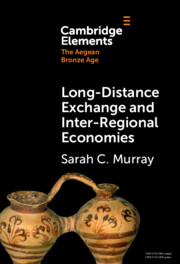69 results

Long-Distance Exchange and Inter-Regional Economies
-
- Published online:
- 12 December 2023
- Print publication:
- 18 January 2024
-
- Element
- Export citation
Cannabis use as a potential mediator between childhood adversity and first-episode psychosis: results from the EU-GEI case–control study
-
- Journal:
- Psychological Medicine / Volume 53 / Issue 15 / November 2023
- Published online by Cambridge University Press:
- 04 May 2023, pp. 7375-7384
-
- Article
-
- You have access
- Open access
- HTML
- Export citation
The association between reasons for first using cannabis, later pattern of use, and risk of first-episode psychosis: the EU-GEI case–control study
-
- Journal:
- Psychological Medicine / Volume 53 / Issue 15 / November 2023
- Published online by Cambridge University Press:
- 02 May 2023, pp. 7418-7427
-
- Article
-
- You have access
- Open access
- HTML
- Export citation
A practical risk calculator for suicidal behavior among transitioning U.S. Army soldiers: results from the Study to Assess Risk and Resilience in Servicemembers-Longitudinal Study (STARRS-LS)
-
- Journal:
- Psychological Medicine / Volume 53 / Issue 15 / November 2023
- Published online by Cambridge University Press:
- 09 March 2023, pp. 7096-7105
-
- Article
- Export citation
Bibliography
-
- Book:
- Male Nudity in the Greek Iron Age
- Published online:
- 04 September 2022
- Print publication:
- 22 September 2022, pp 275-318
-
- Chapter
- Export citation
Plates
-
- Book:
- Male Nudity in the Greek Iron Age
- Published online:
- 04 September 2022
- Print publication:
- 22 September 2022, pp ix-x
-
- Chapter
- Export citation
Dedication
-
- Book:
- Male Nudity in the Greek Iron Age
- Published online:
- 04 September 2022
- Print publication:
- 22 September 2022, pp v-vi
-
- Chapter
- Export citation
Tables
-
- Book:
- Male Nudity in the Greek Iron Age
- Published online:
- 04 September 2022
- Print publication:
- 22 September 2022, pp xiii-xiv
-
- Chapter
- Export citation
Chapter Four - The Lost Wax Method of Production of EIA Bronze Figurines
-
- Book:
- Male Nudity in the Greek Iron Age
- Published online:
- 04 September 2022
- Print publication:
- 22 September 2022, pp 138-171
-
- Chapter
- Export citation
Copyright page
-
- Book:
- Male Nudity in the Greek Iron Age
- Published online:
- 04 September 2022
- Print publication:
- 22 September 2022, pp iv-iv
-
- Chapter
- Export citation
Chapter Three - Iconographic and Regional Patterns in EIA Naked Male Figurines and the History of Ritual Action
-
- Book:
- Male Nudity in the Greek Iron Age
- Published online:
- 04 September 2022
- Print publication:
- 22 September 2022, pp 87-137
-
- Chapter
- Export citation
Preface
-
- Book:
- Male Nudity in the Greek Iron Age
- Published online:
- 04 September 2022
- Print publication:
- 22 September 2022, pp xv-xx
-
- Chapter
- Export citation
Appendix C - Sample of Vase Painting Images
-
- Book:
- Male Nudity in the Greek Iron Age
- Published online:
- 04 September 2022
- Print publication:
- 22 September 2022, pp 267-274
-
- Chapter
- Export citation
Chapter Five - Bronze Figurines, Transformative Processes, and Ritual Power
-
- Book:
- Male Nudity in the Greek Iron Age
- Published online:
- 04 September 2022
- Print publication:
- 22 September 2022, pp 172-210
-
- Chapter
- Export citation
Contents
-
- Book:
- Male Nudity in the Greek Iron Age
- Published online:
- 04 September 2022
- Print publication:
- 22 September 2022, pp vii-viii
-
- Chapter
- Export citation
Appendices
-
- Book:
- Male Nudity in the Greek Iron Age
- Published online:
- 04 September 2022
- Print publication:
- 22 September 2022, pp 249-274
-
- Chapter
- Export citation
Chapter Seven - Method and Approach in the Archaeology of the EIA Aegean
-
- Book:
- Male Nudity in the Greek Iron Age
- Published online:
- 04 September 2022
- Print publication:
- 22 September 2022, pp 232-248
-
- Chapter
- Export citation
Plate Section (PDF Only)
-
- Book:
- Male Nudity in the Greek Iron Age
- Published online:
- 04 September 2022
- Print publication:
- 22 September 2022, pp 323-334
-
- Chapter
- Export citation
Chapter Six - EIA Nudity and Ritual in Historical Perspective
-
- Book:
- Male Nudity in the Greek Iron Age
- Published online:
- 04 September 2022
- Print publication:
- 22 September 2022, pp 211-231
-
- Chapter
- Export citation
Index
-
- Book:
- Male Nudity in the Greek Iron Age
- Published online:
- 04 September 2022
- Print publication:
- 22 September 2022, pp 319-322
-
- Chapter
- Export citation

